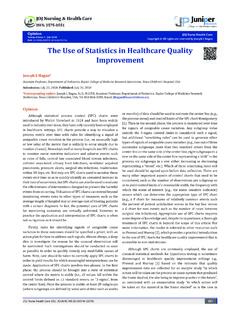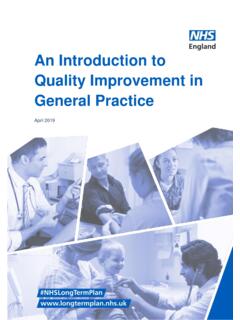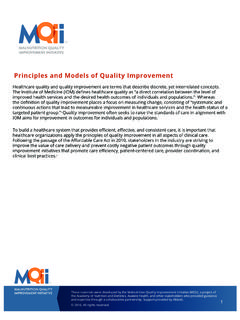Transcription of Quality improvement made simple - Health Foundation
1 Quality improvement made simple What everyone should know about Health care Quality improvementApril 2021 Quick guideThird edition published April edition initially published in August 2013. The design of the guide was then updated in 2016 to reflect the Health Foundation s revised improvement made simple is published by the Health Foundation , 8 Salisbury Square, London EC4Y 8 APISBN: 978-1-911615-56-9 2021 The Health FoundationWritten by Bryan Jones, Esther Kwong and Will Warburton Acknowledgements The authors would like to thank Joanna Bircher, Nick Black, Billy Boland, Mary Dixon-Woods, Tom Downes, Rosie Graham, Nigel Hart, Annie Laverty, Penny Pereira, Amar Shah, Iain Smith and Mirek Skrypak for their helpful suggestions and comments.
2 We would also like to acknowledge the authors of the previous 2013 edition of this guide, which has been one of the Health Foundation s most popular and widely used referencing this publication please use the following URL: Introduction 22. What is Quality and how can it be improved? 63. Underlying principles 134. Approaches and methods 265. Key questions for planning and delivering Quality improvement 326. Where can I find out more?
3 52 References 591 Introduction3 IntroductionWhy does Quality improvement matter?Every Health care system is built on a complex network of care processes and pathways. The Quality of the care delivered by the system depends to a large extent on how well this network functions, and how well the people who provide and manage care work together. The overall aim is simple : to provide high- Quality care to patients and improve the Health of our population.
4 Yet, as every patient and professional can testify, for every process or pathway that works well, there is another that causes delay, wasted effort, frustration or even harm. Quality improvement is about giving the people closest to issues affecting care Quality the time, permission, skills and resources they need to solve them. It involves a systematic and coordinated approach to solving a problem using specific methods and tools with the aim of bringing about a measurable improvement . Done well, Quality improvement can deliver sustained improvements not only in the Quality , experience, productivity and outcomes of care, but also in the lives of the people working in Health 4 Quality improvement made simplecare.
5 For example, it can be used to improve patient access to their GP, streamline the management of hospital outpatient clinics, reduce falls in care homes, or tackle variations between providers in the way processes and activities are delivered. An understanding of Quality improvement is therefore important for anyone who delivers or manages care, as well as for people using care services and wondering how they could be improved. Through Quality improvement there is the potential to create a Health care service capable of ensuring no needless deaths; no needless pain or suffering; no helplessness in those served or serving; no unwanted waiting; no waste; and no one left out.
6 1 What is this guide about?This guide offers an explanation of some popular Quality improvement approaches and methods currently used in Health care and their underlying principles. It also describes the factors that can help to make sure these approaches and methods improve Quality of care processes, pathways and services. 5 IntroductionThere are other methods and interventions that can improve Quality of care, such as education, regulation, incentives and legal action, but these are outside the scope of this guide. Who is this guide for?
7 This guide is written for a general audience and will be most useful to those new to the field of Quality improvement , or those wanting to be reminded of the key points. It is aimed primarily at people either working in or receiving Health care, but is also relevant to social care and other public and third sector services, such as housing and is Quality and how can it be improved?2 7 What is Quality and how can it be improved?What is Quality ? Within Health care, there is no universally accepted definition of Quality . However, the majority of Health care systems around the world have made a commitment to the people using and funding their services to monitor and continuously improve the Quality of care they England, the NHS is organising itself around a single definition of Quality 2: care that is effective, safe and provides as positive an experience as possible by being caring, responsive and person-centred.
8 This definition also states that care should also be well-led, sustainable and equitable, achieved through providers and commissioners working together and in partnership with, and for, local people and communities (see Box 1). Health care systems across the UK are also looking at the environmental impact of the services they provide as part of their efforts to improve care improvement made simpleBox 1: The dimensions of qualityFor people who use servicesSafe Avoiding harm to people from care that is intended to help them.
9 Effective Providing services based on evidence that produce a clear benefit. Experience Caring. Staff involve and treat people with compassion, dignity and respect. Responsive and person-centred. Services respond to people s needs and choices and enable them to be equal partners in their own those providing servicesWell-led They are open and collaborate internally and externally and are committed to learning and They use their resources responsibly and efficiently, providing fair access to all, and according to need of their They provide care that does not vary in Quality because of a person s characteristics.
10 9 What is Quality and how can it be improved?It is important that Health care organisations consider all these dimensions when setting their priorities for improvement . Often the dimensions are complementary and work together. However, there can sometimes be tensions between them that will need to be balanced. It is therefore necessary to consider all stakeholders views and to work together to identify improvement priorities for an organisation or local Health care can we improve Quality ? A long-term, integrated whole-system approach is needed to ensure sustained improvements in Health care Quality .

















